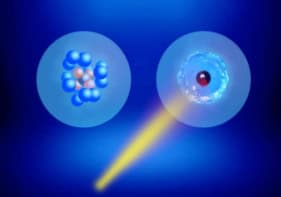A new “supersolid” phase of matter has been created by physicists in the US by cooling helium-4 to ultracold temperatures. Eun-Seong Kim and Moses Chan of Pennsylvania State University say their supersolid behaves like a superfluid – a liquid that flows without resistance - but has all the characteristics of a crystalline solid (E Kim and M H W Chan 2004 Nature 427 225).

All atoms are either bosons or fermions depending on whether their intrinsic angular momentum or “spin” is an integer or half-integer in quantum units. When bosonic atoms like helium-4 are cooled to near absolute zero, they can all collapse into the same quantum ground state to form a Bose-Einstein condensate. Fermionic atoms, on the other hand, obey the Pauli exclusion principle and cannot form such a condensate.
When liquid helium-4 is cooled to below about 2 kelvin, it undergoes Bose-Einstein condensation to become a superfluid. Although theory predicts that superfluidity should also exist in solid helium-4, no such supersolid phase has ever been observed in an experiment.
Chan and Kim first compressed helium-4 gas into a small glass disk made of fused silica that contains atomic-sized pores. Next, they placed this disk in a “torsional oscillator” capsule (see figure) and applied a pressure of over 60 atmospheres. Then they rotated the capsule and measured its oscillation rate as the temperature was lowered to almost absolute zero.
The pair observed that the oscillation rate of the capsule increased suddenly when the temperature fell below about 175 millikelvin. According to Kim and Chan, this meant that the helium-4 had “decoupled” from the pores in the glass disk and had entered a supersolid phase. “In this supersolid, the individual helium-4 atoms are continually flowing – without any friction – but because all the particles are in an identical quantum state, it remains a solid,” Chan told PhysicsWeb.
To test their findings, the duo repeated their experiment with helium-3 atoms – which are fermions. As expected, they found no change in the oscillation period of the capsule. “If our results are confirmed, this means that researchers have now been able to observe Bose-Einstein condensation in gases, liquids and solid phases,” write Kim and Chan.



